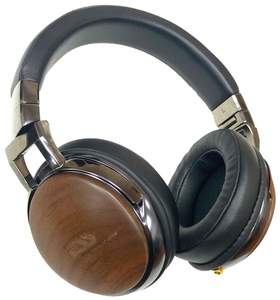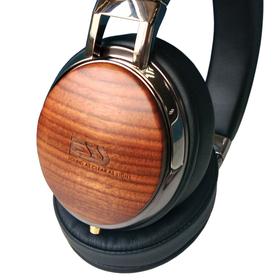
Adam LaBarge, Reviewer
Like me, you might have heard of ESS and their enhanced ESS-Heil Air-Motion Transformer speakers through word of mouth. I have been told I should give their speakers a listen, but unfortunately to date, I have yet to have that opportunity. So, when the chance came to review both of their headphones, I awaited their arrival with anticipation. Currently, ESS offers two headphones, the 252, which is a more standard dynamic driver enclosed headphone, and the 422H, which is a unique hybrid of Heil Air Motion and a coil driver enclosed headphone. This review covers the 252 (retail $129), and we plan to follow up shortly with a review of the 422H.
If, unlike me, you have not previously heard of ESS, you should know that the company is located in California and has been designing and building audiophile and pro-audio speakers since 1972, and now they are one of the first companies ever to bring that Heil technology to headphones. You can buy their products direct via their website or work through your local ESS dealer to find a product that is right for you.
First Impressions
The 252 headphones I was to review arrived in the mail, and they were a joy to unpack. While most people don’t really care about the packaging, first impressions are important. The headphones themselves come in a small zip-up travel case and unfold out of it neatly. The case has enough room to easily hold the headphones and their cable, and traveling with them is easy. While they are not noise canceling headphones, I thought they did a particularly good job of reducing external noises in the office and while on an airplane.
To me, the 252 headphones appear upscale and refined, and while they look modern, the real walnut casings somehow keep them visually tied to earlier audiophile times. The company is proud to state on their website that no two headphones look the same due to their use of real wood.
Listening Experience
 The walnut casings enclose a 50mm Dynamic Orientation driver with a frequency response on 20Hz to 20KHz. They have a sensitivity of 107 +/- 3dB at 1KHz 1mW and an impedance of 32 +/0 15% Ohm. They worked great straight out with my iPhone 6s, geek out 1000 USB DAC/Amplifier, Burson HA-1 headphone amplifier, and the top of the line Pass Labs HPA-1 amplifier.
The walnut casings enclose a 50mm Dynamic Orientation driver with a frequency response on 20Hz to 20KHz. They have a sensitivity of 107 +/- 3dB at 1KHz 1mW and an impedance of 32 +/0 15% Ohm. They worked great straight out with my iPhone 6s, geek out 1000 USB DAC/Amplifier, Burson HA-1 headphone amplifier, and the top of the line Pass Labs HPA-1 amplifier.
For this review, I was able to listen to the ESS 252 headphones on all of the amplifiers listed above, along with the OPPO Sonica DAC and PS Audio Digital Link DAC, all driven from my Apple laptop, streaming lossy and hi-def 24-bit lossless audio. I used the stock cable that comes with the headphones for the entire review.
After several weeks with the 252 headphones, I feel I have a good understanding of their sonic characteristics. And, to me, there are two characteristics that stick out the most. The 252’s are sensitive and transparent enough to show the different traits of the amplifiers that are driving them and reveal the quality and nature of the recording, but, at the same time, they also infuse their own personal sonic traits as well. For example, to me the geek out 1000 amplifier is very forward and generally makes music sound more exciting and in my face, so to speak, than say the more laid back preamplifier like sound of the Pass Labs HPA-1, and the 252’s were able to work with and reveal the traits of both those amplifiers.
With recordings, say for example Miles Davis’ A Tribute to Jack Johnson, listening to that straight out of my computer headphone jack, even at 24-bit, with the 252, the lack of detail from the computer DAC caused me to come the closest I’ve ever been to having a split personality. Basically, the guitar on the left and drums on the right sounded like they were recorded separately in different long hallway-shaped rooms. But, the same recording through the Burson HA-1 and a better DAC, came together. The details of the recording room congealed so that the two panned sides now slightly bled into each other in the center channel and revealed through these small details that the musicians were, in fact, jamming in the same room. The sound staging presented by the 252’s appears to be as good as the equipment backing them. With the Pass Labs HPA-1, the same recording, while being a bit more laid back, revealed a bigger room and offered more echos and bleed over between the recording mics, for my ears to enjoy.
While 252’s do well at sound staging, dynamics, hitting the low lows, the high highs, and revealing detail, their most outstanding traits boiled down to two things. First, the music was always solid, fleshy, and the sound had substances and weight. In other words, the upper bass and lower mid-range were present and emboldened the sound. I do think it encroached and maybe suppressed some of the mid-range, which may lead folks to think that the mid-range isn’t open. I think the mid-range remains open, but since the upper bass isn’t scooped out, you don’t just hear the mid range and low bass. To me this creates a solid sound that has a density to it, and the ability to produce the lower lows backs up that density with real weight. Secondly, while the 252’s were detailed and were able to reveal separation and staging in a recording, or even tape/microphone hum, the top end always remained smooth. Not 211 tube amplifier liquid smooth, and not energy dampening smooth, but smooth in a way that made trash metal, noise music or a really dynamic and loud horn just not as annoying or piercing as they can be. In a way, the smoothness added a protective layer between my ears and the blistering sounds from artist like Merzbow or God Speed You Black Emperor. Kind of like sunblock on a skin-peeling day.
Conclusion
The 252’s offer a significant audiophile experience and are especially compelling for the price point. If you are in the market for enclosed headphones, these are indeed worth listening to. They get better as their backing equipment improves, so they would make a great pair of headphones to grow into as your budget allows. Lastly, and obviously this is just as personal as the part of this review that is about how they sound, the fit for me was a bit tight. When I was wearing glasses with larger frames, the squeeze sometimes got annoying. Other times, it didn’t, which was weird, but then again sometimes my glasses just by themselves are irritating, while most days they aren’t.
![]()
